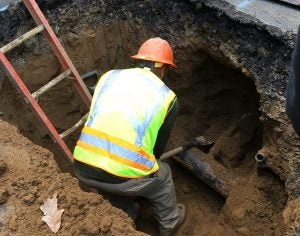Tom Neltner, J.D., is Chemicals Policy Director
The Cincinnati City Council enacted three ordinances in June 2017 that establish an innovative legal framework to replace the city’s 27,000 lead service lines (LSLs) over the next 15 years. The Council acted after finding that “high levels of lead in water create serious health risks to residents of the City, particularly young children, and using lead service lines between public water mains and properties increases the risk that the lead content of drinking water to the properties served will increase to a dangerous level” and that “replacing lead service lines is in the best interest of the public health, safety, morals, and general welfare.” Although the City stopped allowing new LSLs in 1927, an estimated 1 in 9 service connections still have a portion made of lead pipe.
Cincinnati’s program is based on Madison, Wisconsin’s successful effort, which began in 2000 and was completed in 2011. Cincinnati is roughly three times larger than Madison in terms of population, service connections, and LSLs.
Under the program, residential property owners within Greater Cincinnati Water Works’ (GCWW) service area can receive between 40 and 50% off of the cost of replacing the portion of the LSL on their property up to $1,500 if they agree to have GCWW arrange for the replacement. Owners within the limits of the City of Cincinnati may choose to have the remaining cost assessed semiannually on their property tax bill and repaid over 5 or 10 years. Property assessments must be approved by the political entity where the property resides. As of today the assessment option is only available for the residential properties in the City. However, GCWW is reaching out to the other jurisdictions it serves to discuss expanding the assessment program to those jurisdictions as well.
GCWW will also be replacing the portion of the LSL on public property so that the entire service line is replaced. The City is committed to fund its share of the work from GCWW’s Capital Budget.
While based on Madison’s program, Cincinnati’s approach varies in three significant ways. It:
- Prohibits existing LSLs as of June 28, 2017 and provides an automatic grace period to all property owners. The requirement to remove the private LSL is triggered when the City serves notice to the owner that they need to replace the LSL. The owner must choose within 30 days to replace the LSL at their own cost with their own contractor in coordination with GCWW, or, to contract with GCWW to complete the work. Any unpaid costs after deduction of GCWW cost-sharing can be assessed to the property. In contrast, Madison’s ordinance did not prohibit existing LSLs and used the notice to trigger an investigation and extended replacement schedule.
- Requires landlords to inform prospective tenants in writing prior to the tenant’s signing the lease if the unit is serviced by an LSL. Landlords are directed to the GCWW’s webpage to check records of the material composition of their service line. The City provides a useful interactive map. Cincinnati is the first community we are aware of that alerts prospective tenants about LSLs so they can consider the risks before signing the lease.
- Establishes a “Help Eliminate Lead Pipes” (HELP) fund to handle donations from City employees, GCWW customers, corporations, and others to assist low-income residential property owners with the cost of replacement of LSLs on private property.
Cincinnati’s ordinances are a follow-up to its October 2016 directive to GCWW to develop an LSL replacement program that 1) replaces all lines within 15 years, 2) uses property assessment as a financing option; and 3) sets up a customer assistance program.
GCWW’s notice to property owners that they must replace their LSL is significant because once the notice is delivered, the private LSL replacement is required within the GCWW project timeline and enforceable by GCWW. The ordinance identifies three situations that will trigger the notice and removal of a lead pipe from service:
- GCWW plans to replace the water main that connects to the LSL. The ordinance prohibits the utility from reconnecting the main to existing lead pipe. This provision effectively bans partial LSL replacement.
- An existing LSL is leaking. The line can be temporarily repaired but then must be replaced with copper.
- LSL is disturbed for any other reason such as renovation, demolition and rebuild.
The cost sharing with GCWW is only available if the work is performed by GCWW or its contractor. This approach enables the City to manage the cost and ensure the work is done properly and efficiently. Low-income residents who are senior citizens will be asked to pay half the cost of replacement. If the resident property owner is low income but not a senior citizen, they pay 55% of the cost. All other property owners pay 60%. GCWW’s maximum cost share is $1,500.
GCWW has the flexibility to prioritize LSL replacement based on the public health risk and economic consideration and anticipates putting any school, child care provider, or other business or activity frequented by children as a high priority.
The three ordinances only provide the legal framework and the resources for the City to successfully replace all LSLs. The difficult work of implementation falls largely on GCWW and not all property owners will appreciate the need to replace lead pipes. A key to success is the HELP fund to minimize the burden on low-income property owners. With these cautions, we think the approach is a model that should be considered by other communities.










